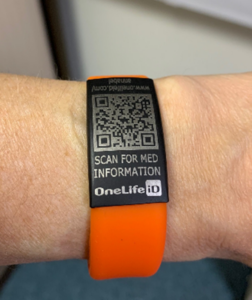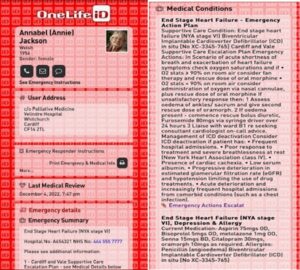Dr Elin Harding, Palliative Medicine Doctor, Clinical Research Fellow, Velindre Cancer Centre, Cardiff, UK ORCID 0009-0003-7100-7998
Dr Martha Thomas, Foundation Year 1 Doctor, Princess of Wales, Bridgend, UK 0009-0004-5908-8550
Dr Nikki Pease, Palliative Medicine Consultant, Velindre Cancer Centre, Cardiff, UK 0000-0002-8994-749
In the last year of life, palliative patients increasingly access emergency unscheduled care via 999 ambulance [1]. Such situations are more difficult when information about a patient’s primary disease, comorbidities, treatment options, advance care plans and resuscitation status are not readily available to attending healthcare professionals. It is well documented that patients with advanced end organ failure would prefer a focus on enhanced quality of life, improved symptom control and opportunity to spend more time with loved ones [2].

The heart failure supportive care service in South Wales, which cares for patients in the last years of life, has helped patients gain a sense of control over their medical condition by working closely with them to develop comprehensive care plans which encompass patient preference and wishes to avoid unnecessary hospital admissions [3]. To what extent such plans are available to the attending healthcare professional in an emergency situation is unclear. If acceptable to patients QR code wristband technology may provide a significant step forward by providing an easily updated, readily accessible, limitless platform for patients, carers and healthcare professionals to access patient information.
In November 2022, the Welsh Government released a report [4] into wearable medical identification which explored widely available engraved jewellery and more recent technological advances including the focus of this project, QR code jewellery. Whilst historically the ‘Message in a bottle’ system (pic 1) sought to improve availability of information, the container capacity (approx. 200mls) and ability to update information were limited. Traditional medical information engraved jewellery similarly has limited available space to convey information which has led to mixed outcomes and opinions [5]. 
With QR code wristbands, typically patients wear a silicone wristband (pic 2) with an unique QR code on the outwardly visible surface and a security 4-digit PIN code visible only when the wristband is inverted, which takes you to a personal profile for that patient (pic 3). In 2023 all ambulances in Wales were issued with computer tablets capable of reading QR codes, thereby enabling access to individual patient specific healthcare information including but not limited to:

- Patient demographics
- A photograph of the patient
- Several emergency contact numbers for next of kin
- Detailed information relating to the patient’s life limiting diagnosis
- Patient specific clinical care plans
- Clinical contacts e.g. community specialist nurses
- Treatment plans in case of emergency
- Patient’s preferences with respect to place of care
- Advance care plans
- Do Not Attempt Cardiopulmonary Resuscitation (DNACPR) forms.
Acknowledging the use of QR code wristbands could facilitate timely access to crucial patient information; understanding if and how such systems are acceptable to palliative patients is vital.
In a Supportive and Palliative Care Clinic, 16 randomly selected palliative patients (age range 46-99 years, 12 male) and their relatives were shown the QR wristband system linked to a test patient site; patients /relatives were then asked to complete a survey seeking their views on the QR code wristbands system. Of the patients included, 62.5% had accessed emergency unscheduled healthcare in the preceding two years. Qualitative data indicated some patients and their relatives did not feel confident relaying complex medical information to HCPs in an emergency. Two patients commented that the QR wristband could improve their quality of life by enabling them to be more independent;
‘Friends would be happier to take me out and about places as they worry about forgetting information’
‘What would happen if I travel abroad? Would it still work as a system in, for example Portugal?’
With regard to maintaining data, 94% patients were confident, with the help of clinic staff, their information would be kept up to date and were largely unconcerned by their medical data being hosted in keeping with GDPR yet outside of NHS.
‘I like that it would be easy to update my changing management plan’
‘The Benefits of the (QR) system outweighs concerns about data risk with an external company. I like the idea that information is always on your person when out and about’.
Data suggests QR code wristbands are acceptable to palliative patients and as such offer a potential solution to the inaccessibility of important, clinically relevant, medical information at a crucial time in patients’ care. Overall, patient feedback on the QR wristband system was positive, with the biggest patient concern being the wristband itself, where two patients felt wearing the wristband reminded them of their illness and previous hospital admissions, they would prefer an alternative way of carrying the QR code. Alternative QR code wearable items include necklaces, watch tags, or ID cards. Implementation of this system may significantly improve communication to emergency healthcare professionals, reduce patient and relative anxiety, and ultimately improve quality of life.
Take home thoughts:
- QR code wristbands have the potential to improve accessibility of medical information at a crucial time for palliative care patients, could this intervention reduce unnecessary hospital admissions?
- To ensure ease of interpretation for emergency healthcare professionals, what format should patient treatment care plans take and what information should they include?
- What alternatives are there to the QR code wristband and are these more acceptable to palliative patients?
- Is this something that could be used in other specialties of medicine to improve communication of complex management plans to other teams such as ambulance staff and GPs?
References
- Marie Curie Improving evening and weekend care for dying people – Marie Curie. [Internet]. 2022 [cited 2023 Oct 16]. Available from: https://www.mariecurie.org.uk/globalassets/media/documents/research/publications/h429_out-of-hours-palliative-care.pdf
- Kraai IH, Vermeulen KM, Luttik ML, Hoekstra T, Jaarsma T, Hillege HL. Preferences of heart failure patients in daily clinical practice: Quality of life or longevity? European Journal of Heart Failure. 2013;15(10):1113–21. doi:10.1093/eurjhf/hft071
- Atkinson C, Hughes S, Richards L, Sim VM, Phillips J, John IJ, et al. Palliation of heart failure: Value-based supportive care. BMJ Supportive & Palliative Care. 2022; doi:10.1136/bmjspcare-2021-003378
- Life Sciences Hub Wales, Welsh Government. Intelligence Report: Wearable Medical Identification. November 2022. 20221026.
- Rahman, S et al. Medical identification or alert jewellery: an opportunity to save lives or an unreliable hindrance? Anaesthesia vol. 72,9 (2017): 1139-1145.
Authors
Harding E, Palliative Medicine Doctor, Clinical Research Fellow, Velindre Cancer Centre 0009-0003-7100-7998
Thomas M, Foundation Year 1 Doctor, Princess of Wales, 0009-0004-5908-8550
Pease N, Palliative Medicine Consultant, Velindre Cancer Centre 0000-0002-8994-749
Declaration of interests
We have read and understood the BMJ Group policy on declaration of interests and declare the following interests: None